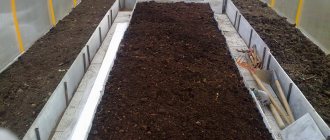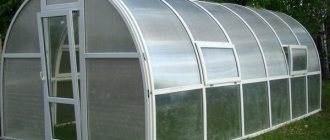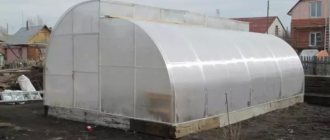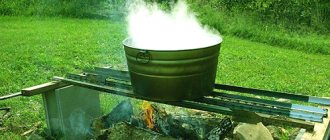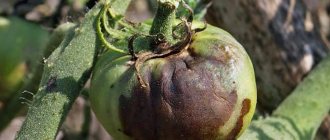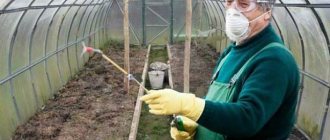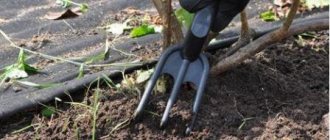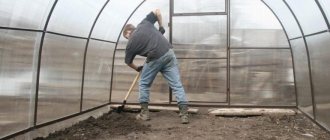Preparing the greenhouse for spring takes me from 5 to 8 hours.
Tell me, is it a lot?
And I think that I can still cope quickly, given the considerable amount of work being performed.
But in the summer, my tomatoes get sick a little and require rare feedings.
Today I will share a step-by-step plan on how to properly prepare a greenhouse for planting and sowing.
Why treat a greenhouse in the spring
After several years of operation of the greenhouse, pathogenic microbes and other microorganisms can live and multiply on its walls and in the soil. To protect the plants and not harm the crops, spring treatment of the structure is necessary.
During their growth, seedlings receive nutrients from the soil. Therefore, it is necessary to prepare the greenhouse correctly for the new season in the spring. Necessary:
- Inspect the greenhouse for damage. If they have been identified, eliminate them;
- carry out complete disinfection;
- fight pests whose habitat is in the ground;
- restore soil fertility.
You can protect the future harvest and the structure if you choose the right drugs to combat parasites and carry out the necessary procedures on time.
When to treat
Treatment of the greenhouse in the spring should begin before the snow melts - it should be brought in and covered with it over the entire area of the soil. For initial procedures, its role cannot be overestimated. Benefits of using snow:
- melt water penetrates the soil, saturating it with useful microelements;
- Because of the snow, the ground freezes, which leads to the death of pests that have not yet awakened.
Attention! You can get rid of ice from polycarbonate if you open all windows and doors at sub-zero temperatures. When the temperature levels out, the crust will be easy to remove.
In the last winter month, the soil needs to be cleaned and disinfected. In addition, greenhouses need treatment. In particular, if wooden parts are rotten, then replacing them is impossible. Metal structures that have become corroded should:
- clear;
- treat to get rid of rust;
- apply primer;
- paint.
You can use folk remedies for these purposes.
Stages of preparing a greenhouse for the season
In order to properly treat the greenhouse for spring sowing, a lot needs to be done. In addition to preparing the soil, you need to wash and disinfect the structure itself, which can become a breeding ground for bacteria and pests.
Freeing up space
Before starting work on processing the greenhouse, you will have to remove everything from it that could interfere with this process. Even the supports that support the roof in the event of a large amount of snow must be dismantled.
Everything that is taken out of the greenhouse must be carefully inspected and processed:
- Whitewash wooden structures with lime and paint glue. If the elements are rotten, they require replacement;
- treat metal products from rust if pockets of rust have been identified. This can be done using both folk remedies and purchased ones. After this manipulation, paint the metal supports.
Attention! If heating equipment is installed in the greenhouse, it needs to be painted. However, it is not recommended to use oil paint - it reduces heat transfer.
If everything that was taken out is not damaged, then you can refuse processing
Garbage collection and recycling
Be sure to get rid of last year's weeds, ropes and pegs that were used by gardeners to tie up vegetable crops. Roots, leaves, and stems of plants also need to be removed.
Collected garbage must be burned. At the same time, the ash that will be obtained during the recycling process will be an excellent fertilizer. It will help saturate the earth with useful microelements (zinc, phosphorus, iron, etc.). If you use dry ash for fertilizer, then it must be scattered before digging the soil at the rate of 3-5 cups per 1 square meter. m. If for feeding, then you need to dissolve 1 glass of the substance in a bucket of water.
Fighting dust and dirt
It is necessary to provide clean conditions for growing seedlings and vegetable crops by washing the greenhouse. You need to remove dirt and layers of dust with:
- frame. It is treated with a soap solution, then it is collected back with a rag. If there was an invasion of parasites in the previous season, then a remedy for the detected pests should be added to the solution;
- polycarbonate plates, while they are processed on both sides. For washing, use a soft rag or sponge with soapy water. From the outside it can be washed off with high pressure of water, but inside you need to do this carefully - it is undesirable for soap to get into the ground.
If you follow these rules, you can clean the greenhouse without harming the soil.
Greenhouse disinfection
After the greenhouse has been washed, you need to start disinfecting it. Bordeaux mixture is used to combat diseases. Some gardeners who prefer folk remedies to combat diseases and pests resort to a decoction of pine needles.
You need to prepare it as follows: fill the bucket halfway with pine branches, add liquid. When this remedy is infused, it can be used. To quickly prepare this product, you can cook it for 20 minutes. Summer residents can also replace pine needles with nettles - the preparation of the decoction is similar. If the greenhouse is severely damaged by fungal infections, then you can resort to fumigation.
Attention! Before this procedure, all the cracks in the greenhouse must be sealed so that the vapors of the product used do not evaporate into the air.
Fumigation is often done by gardeners, since this way they can treat the soil and the structure itself.
Preparing the soil for planting
Disinfection methods acting on the frame make it possible to reduce labor costs for soil cultivation. According to the rules, you need to change its top layer (the first 12-15 cm) with a new one every year. But there are alternative replacement methods:
- tilling the land with boiling water - per 1 sq. m. requires 3 buckets of liquid;
- pour boiling water and cover the soil. The resulting steam penetrates deeply, destroying pests;
- soil disinfection with a 1% solution of potassium permanganate or a 3% solution of nitrafen. This will help exterminate insects hibernating in the soil;
- disinfection with carbation at a concentration of 2%.
Other chemicals are best used in the fall.
Repair
The preparation of the greenhouse begins with an inspection.
You can get an idea of the integrity of the structure only if you clear the roof and walls of snow. There are probably a couple of holes in the walls and ceiling that need to be repaired. It is possible that celluloid film may not survive the winter, and then it has to be replaced.
Many gardeners pour snow into the greenhouse for the winter. Such a pillow will prevent deep freezing of the soil, maintaining soil fertility. If there is snow inside, it may need to be shoveled out.
How to fertilize the soil in a greenhouse in spring
When sowing seeds, you can use any fertilizer. For small households, it is better to use natural or organic fertilizer. In particular, phosphorus fertilizers can be replaced with bone meal.
It must be sprayed over the beds and sealed in place using a hoe or flat cutter. After such fertilization, you need to water and cover the soil.
Manure is often used to increase soil fertility. But it can be replaced with the following mixtures:
- turf soil and peat - in a ratio of 1 to 3;
- peat, sawdust, mullein – 3:1:0.5;
- ammonium nitrate, superphosphate, potassium chloride;
- phosphorus and potassium;
- bird droppings. Dissolve 1 matchbox with these contents in a 10 liter bucket of water.
Mix the components of the last solution well and let it brew for a day.
Fertilizer
If the site was not fertilized in the fall, it should be done in the spring.
Superphosphate
Wood ash
Ammonium nitrate
Of the organic fertilizers that have performed well:
- peat (light high peat or dark lowland, transitional), pure peat is used only as part of compost;
- humus;
- prefabricated compost (peat, manure, fallen leaves, wood ash, slaked soda, soil);
- rotted manure.
Greenhouse soil and mineral fertilizers are needed:
- simple superphosphate (apply before digging, pre-dilute with water in accordance with the instructions and leave for 3 days);
- wood ash for acidic and neutral soils (2 cups of ash per bucket of water);
- ammonium nitrate (for any type of soil);
- microfertilizers.
The sleigh is prepared in the summer, and the greenhouse in the winter. You need to get down to business in mid-February - early March, when you sow seeds for seedlings, decisively overcoming winter laziness. Otherwise, you will have to buy vegetables and fruits to prepare for the winter at the market.
How to prepare the soil in a greenhouse in spring
Basically, the beds begin to be prepared for spring planting in the fall. During this period, the soil is fertilized, mulched with small branches and residues from plant tops. If these procedures were carried out in the fall, then nothing more needs to be done in the spring.
Mulching the soil in a greenhouse
To fertilize the soil in the fall, gardeners use mineral and organic fertilizers. This task can be accomplished by mulch made from crushed tops of weeds and vegetables. A layer of these products is placed on the beds; digging is not necessary.
This is due to the fact that mulch retains necessary moisture in the soil. If you don’t dig up the soil, you can simply loosen it.
Sowing green manure
To increase the fertility of beds, various means are used, including mustard and oilseed radish. Sowing such green manures is accompanied by the following rules:
- the soil must be prepared - fertilized in the fall, loosened without turning the top layer. Loose soil is the best springboard for their emergence and growth;
- no beds or furrows are needed for sowing;
- Water the seeds and cover.
In those beds where mustard grew, there is no need to use nitrogen fertilizers.
Accommodation
The optimal location for a greenhouse is a well-drained area with a flat surface. When installing glazed heated structures, it is important that the subsoil located below the fertile soil layer is sandy: in this case, there will be no stagnation of water and loss of crops. If the area is clayey, before starting work you should make a cushion of gravel (lower layer of subsoil) and sand (upper layer of subsoil). Groundwater should be located no closer than 1.2-1.5 m from the soil surface in the garden bed. As a last resort, drainage grooves can be dug around the greenhouse.
The most correct location of the greenhouse is as follows: the longitudinal axis of its frame is directed from north to south with a deviation to the west of approximately 15-20° (that is, the slopes of the greenhouse are oriented to the west and east). It is with this placement that sunlight evenly warms all surfaces and provides a milder thermal regime during periods of possible overheating. You can also ensure that the greenhouse is protected from the winds by garden trees or other buildings. And reflective screens coated with white oil paint, which are installed outside at a distance of 1-2 m from the “plant house,” will help to avoid heat loss from the north side. They are designed to create additional illumination of the structure due to reflected sunlight.
Methods for disinfecting greenhouses and soil
To cultivate the soil and polycarbonate greenhouse in the spring before planting seeds or seedlings, different methods are used. This must be done in order to exterminate fungal infections and pests overwintering in the soil or on the walls of the structure. Popular methods are biological, chemical and temperature.
Biological
More and more gardeners and farmers decide to process the polycarbonate greenhouse in the spring using a biological method. To do this, you should purchase a special preparation, dilute it and treat the soil with the resulting solution. This method is inferior in efficiency to chemicals, but the harvest will be environmentally friendly.
Attention! When using biological agents for treatment for the purpose of prevention, the effect of their action will be much higher.
Preparations that do not contain dangerous chemical compounds can destroy pests and increase yield. There cannot be an overdose, but fertilizers must be applied to moist, warm soil.
Chemical
Gardeners resort to the use of special means if they need to disinfect structures and plants. Chemicals will save time during this procedure. But there is one significant drawback: they penetrate deep into the soil, vegetables, fruits, berries, etc.
The range of such products is wide, so you need to choose the one that will solve the problem.
Temperature method
This method of soil treatment is simple - it is based on the effects of high and low temperatures. In the second case, the greenhouse is opened during cold weather without covering the soil with snow. Frost can destroy parasite larvae that live in the soil and can harm future plants.
The steaming procedure will also help disinfect the soil. For this purpose, it is poured with plenty of boiling water.
Attention! The volume of liquid can be up to 100 liters.
After completing this manipulation, the ground must be covered so that all moisture remains in it. Approximately 80% of dangerous microorganisms will die under the influence of steam.
How and with what to properly treat a greenhouse against diseases
Pathogenic microorganisms can hide in the soil and in the greenhouse. Therefore, the entire structure needs to be processed. To do this, gardeners resort to different methods, both folk and chemical.
Fitosporin
This product is used to destroy late blight. This infection develops in humid and warm climates. If you do not treat the greenhouse in the spring, the entire tomato crop may die.
You can buy phytosporin in the form of liquid, powder and paste. If the solution was prepared correctly, it can be stored for 12 months in a cool, dark place.
To more effectively combat late blight, you can prepare a solution with phytosporin and other means. For a bucket of water you will need:
- 4 tbsp phytosporin solution;
- 3 tbsp. hydrogen peroxide;
- 10 metronidazole tablets.
The resulting solution can be used to treat soil and greenhouses. This disinfection must be carried out every 10 days throughout the season.
Sulfur checker
Using this product 1-2 times during the season will help you forget about diseases and parasites. But the sulfur bomb has one big drawback - both dangerous and beneficial microorganisms die.
They are produced in the form of tablets, which are equipped with a wick. To process a greenhouse, you need to put the required number of tablets into it and light the wick. During the procedure, all openings of the greenhouse must be tightly closed.
Attention! The structure should be treated with this method only 14 days before planting vegetable crops.
To use a sulfur bomb, certain conditions must be met:
- the temperature in the greenhouse should be at least 10 degrees Celsius with a plus sign;
- the soil should be dry at a depth of 10 centimeters.
You need to think before using this product, as it reduces fertility and causes corrosion of metal products.
Copper sulfate
With the help of this solution, summer residents destroy fungal infections. Spring treatment of the greenhouse with copper sulfate will not only get rid of the fungus, but also the larvae of parasites.
I have been using this solution for a long time to prevent and combat diseases. The concentration of the finished product depends on this. In the first case, 75 g of the drug must be diluted in a bucket of water, and if outbreaks of infections have been noticed, then the proportion increases to 150 g per bucket of water.
To work with copper sulfate, personal protective equipment is required. Treatment with this solution should be carried out no earlier than a month before planting begins. In this case, the air temperature in the greenhouse should be no less than 10 and no more than 15 degrees Celsius with a plus sign.
Potassium permangantsovka
Potassium permanganate is used to treat the soil before sowing. Every year you don’t have to change the top layer of soil, but it’s better not to neglect disinfection. Using potassium permanganate for these purposes has the following advantages:
- extermination of pathogens;
- stimulation of biological processes;
- pest control.
Attention! Manganese solution is only suitable for treating peat, turf and black earth soil.
Always prepare a fresh solution of potassium permanganate. For 10 liters of liquid, 5 g of manganese crystals is sufficient.
Bordeaux mixture
This remedy is prepared from a solution of copper sulfate and diluted lime. Preparation:
- Dilute copper sulfate in a small amount of water at a temperature of 50 degrees, mix thoroughly;
- add more liquid to obtain the required volume;
- dilute slaked lime in water;
- mix the two resulting solutions.
For processing 1 sq.m. you need 10 liters. Bordeaux mixture is used to combat fungi and bacteria that grow on plants.
White
In summer, an organic coating forms on the walls of the greenhouse, which must be removed. If this is not done, bacteria will begin to multiply in it. This will lead to plant diseases, and the crop will not be stored for a long time.
You can avoid such consequences if you use white to kill bacteria. It can also be used to disinfect gardening equipment.
Whiteness is an excellent antiseptic, but it is better to refrain from using it to treat the soil and wash a polycarbonate greenhouse.
Laundry soap
Vegetable growers often do not welcome the use of chemicals. To treat greenhouses they use laundry soap, preferably a 72% bar. It needs to be grated and added to a container with warm liquid. Next, you need to mix well until completely dissolved.
The resulting mixture should be applied to walls, wood and metal products for 120 minutes. After this time, it must be washed off with water. The procedure must be performed carefully so that the solution does not get on the soil.
Farmayod
The drug is used to combat all types of infections and pests. It is available in liquid form. To treat a polycarbonate greenhouse in the spring before planting, you need to use a sprayer.
Application of Pharmaiod:
- You need to fill the sprayer with liquid and add the drug to it. The proportions are indicated in the instructions;
- Pharmaiod is thick, so it needs to be shaken to completely dissolve;
- use of the product requires personal protection.
Attention! After treating the greenhouse with Pharmaiod, it must be tightly closed and not entered for 4 days.
After this period has expired, you can begin planting work.
What to do if the earth is “tired”?
Tired earth in a greenhouse is nothing more than a lack of fertility. Every year, plants take all the nutrients from the earth, depleting and weakening it. To get a new crop, you need nitrogen, phosphorus, calcium, potassium and much more. Therefore, reserves of useful substances should be replenished.
The easiest way to increase soil fertility is to
sow green manure in a greenhouse .
This is the name of plants that form a large volume of green mass in a short time: phacelia, watercress, vetch, mustard, rye, oats, clover. Their shoots and roots become an excellent source of organic matter and soil microorganisms. 3 kg of such greenery replaces 1.5 kg of manure, which has always been considered the best fertilizer for the soil. When green manure sprouts and grows, they are cut off and then plowed into the soil to a depth of 2–3 cm. The dead roots of green manure become food for worms, which loosen the soil, improve its structure and saturate the soil with air. After 1–2 weeks, the main crops can be planted in the plowed area.
Handling Precautions
Basically, chemicals are used to disinfect a greenhouse, so when working with them you need to follow certain rules. This is necessary to avoid poisoning.
- When making mixtures for processing polycarbonate greenhouses in the spring and working with them, be sure to use protective equipment: gloves, goggles, masks or respirators, gowns, etc.
- Smoking, drinking and eating are prohibited in the building where chemicals are stored.
- After finishing the treatment, ventilate and wash the clothes the gardener was wearing.
- Wash exposed areas of the body thoroughly under water.
- Rinse your mouth and nose.
If a greenhouse is treated with a sulfur bomb, then you need to exit the structure immediately after lighting the wick. You cannot enter it for several days.
Tilling the soil and greenhouse are important steps before starting gardening work. Therefore, you need to approach these procedures responsibly, following all recommendations.
